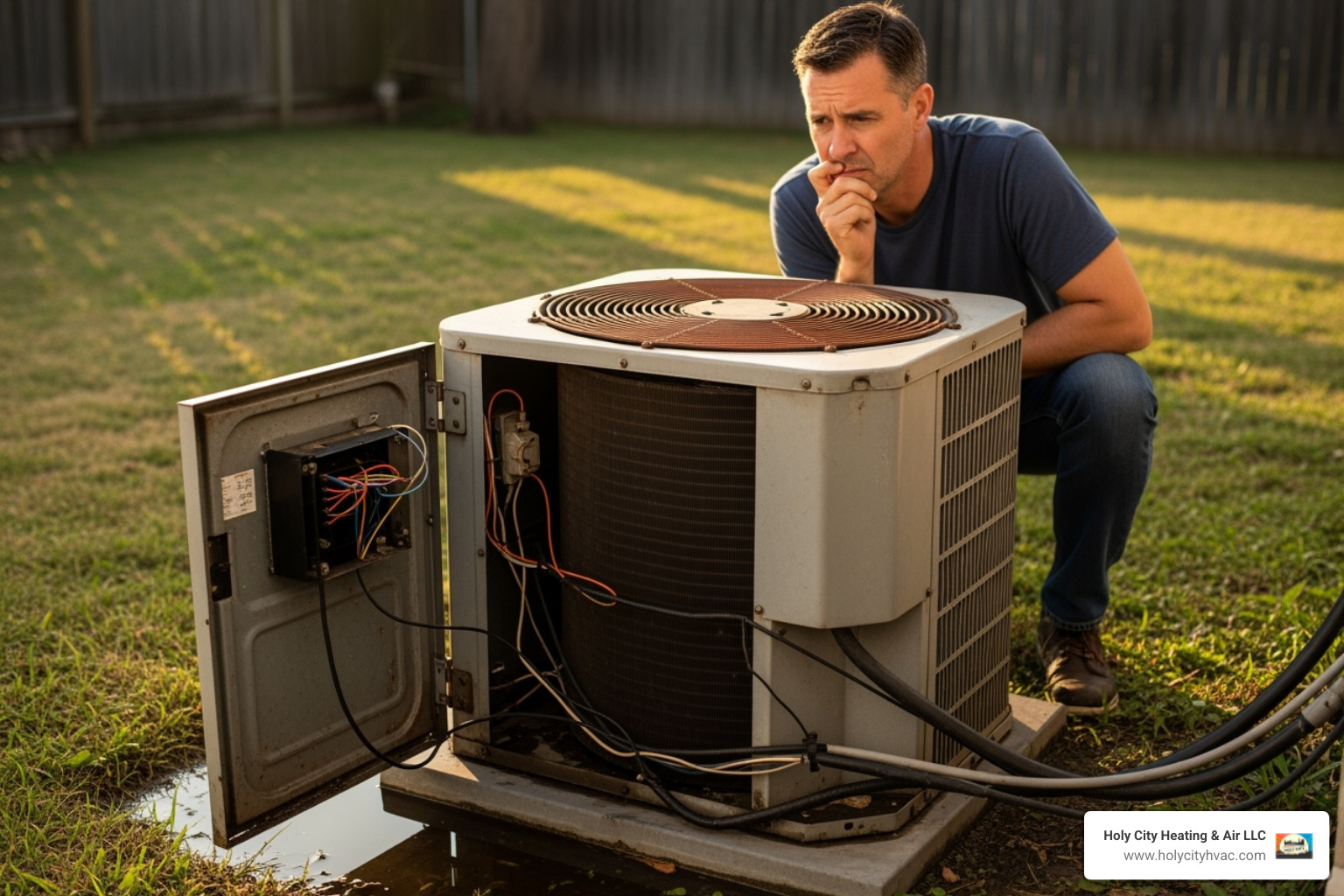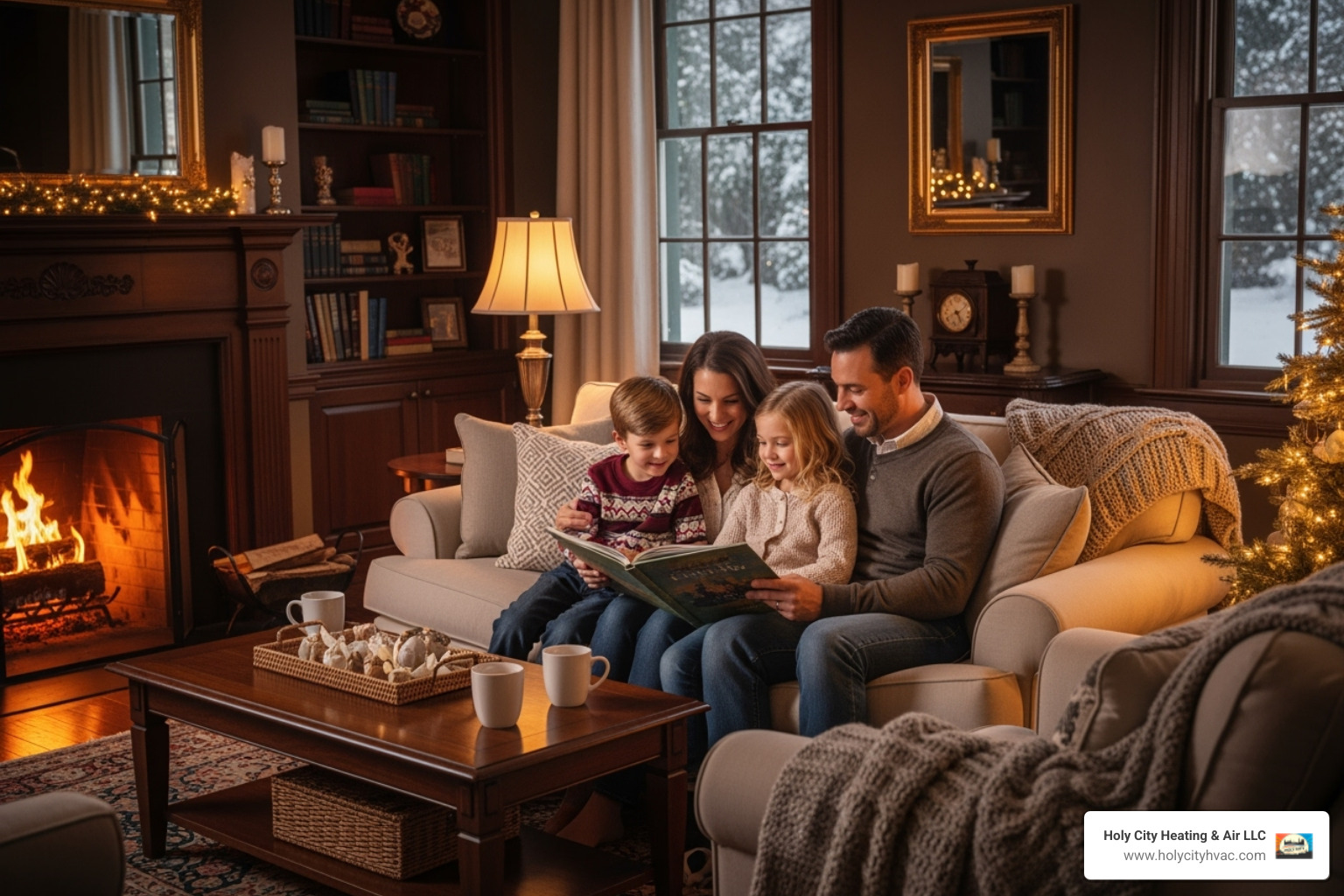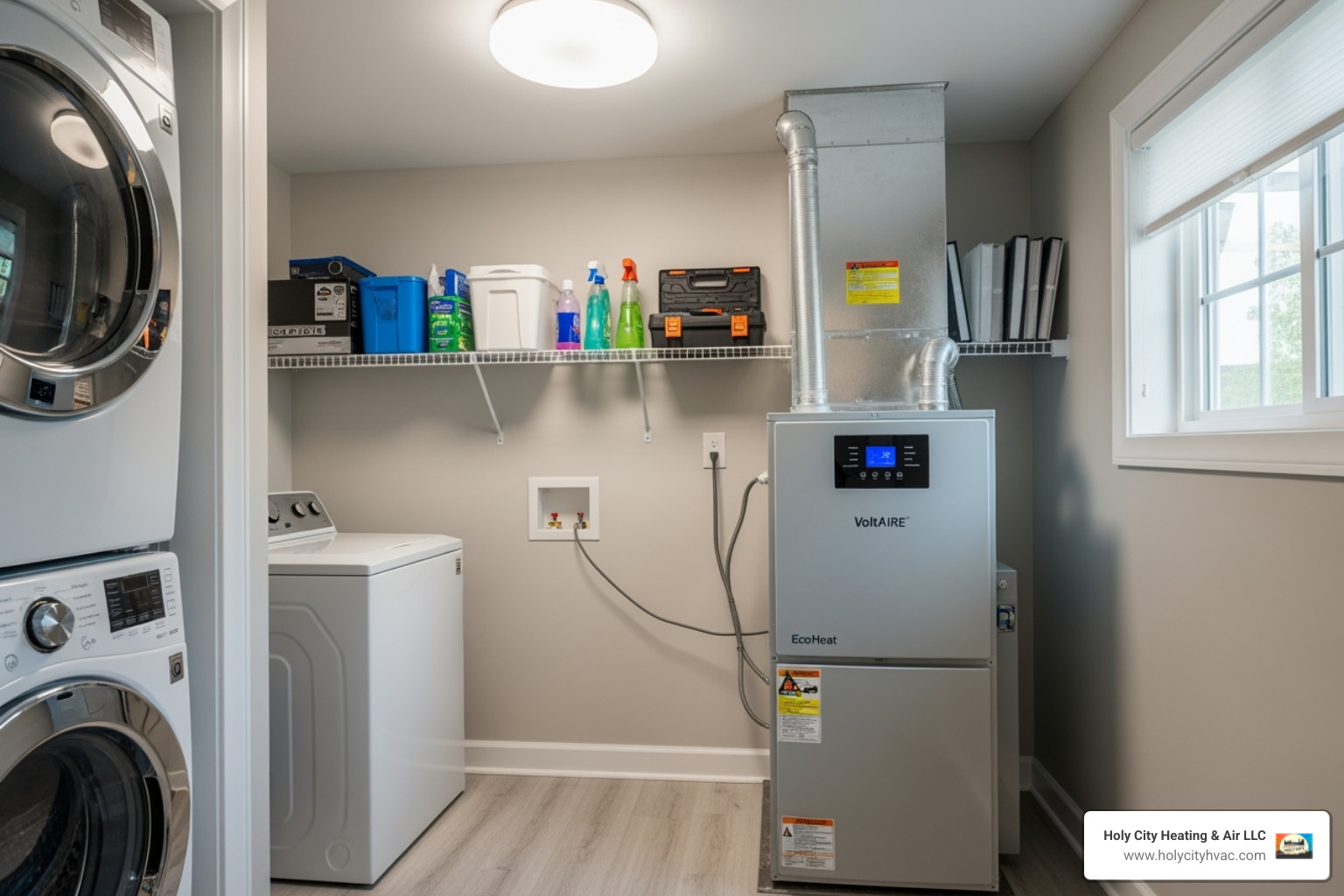
Why Understanding AC Replacement Matters for Charleston Homeowners
When your air conditioner starts acting up during a sweltering Charleston summer, knowing about replacement of ac options becomes crucial for your comfort and wallet. The decision to replace your AC unit affects your home's comfort, energy bills, and peace of mind for the next 10-15 years.
Key indicators it's time for AC replacement:
- Age: Units over 10-15 years old are nearing end of life
- Frequent repairs: Using the "$5,000 rule" (age × repair cost > $5,000)
- Rising energy bills: Poor efficiency from aging components
- Comfort issues: Uneven cooling, humidity problems, or strange noises
- R-22 refrigerant: Phased-out Freon makes repairs expensive
- Poor performance: Constant running or frozen coils
The average lifespan of a central air conditioning unit is 10-15 years, and air conditioning accounts for 12-27% of your monthly power bills. Understanding when to repair versus replace can save you thousands in the long run.
Modern AC units offer significant advantages over older systems. Higher SEER2 ratings mean better energy efficiency, while variable-speed technology provides superior comfort control. The phase-out of R-22 refrigerant has made older units more expensive to maintain, pushing many homeowners toward replacement.
The replacement process involves several key decisions: choosing the right size through proper load calculations, selecting efficiency ratings that match your climate, and understanding the difference between single-stage, two-stage, and variable-speed systems.

Is It Time? Key Signs Your AC Needs Replacing
Figuring out whether to patch up your old air conditioner or invest in a replacement of ac doesn't have to keep you up at night. As Charleston homeowners, we know how much you depend on your AC when the summer heat and humidity roll in. Let's walk through the telltale signs that your trusty cooling companion might be ready for retirement.

The Age Factor and the '5,000 Rule'
Your AC's age tells a big part of the story. Most central air systems live productive lives for about 10 to 15 years. Once your unit crosses that threshold, it's like an aging car – it might still run, but you'll likely face more breakdowns and higher energy bills.
Here's where the clever '$5,000 rule' comes in handy. Simply multiply your unit's age by the cost of the needed repair. If that number exceeds $5,000, you're usually better off with a replacement of ac instead of throwing good money after bad.
Let's say your 12-year-old system needs a $500 repair. That's 12 × $500 = $6,000, suggesting replacement makes more financial sense. But if your 8-year-old unit needs that same $500 fix, you get 8 × $500 = $4,000, making the repair worthwhile.
When repair calls become as regular as your morning coffee, it's time to consider replacement. Your AC system accounts for a significant chunk of your monthly energy bill – anywhere from 12% to 27% according to U.S. Energy Information Administration data. An aging, struggling unit works harder and costs more to operate, often doubling your cooling costs compared to a modern, efficient system.
Performance and Comfort Issues
Your AC unit has its own way of crying for help through poor performance. Uneven cooling throughout your home is a classic red flag – when your bedroom feels like the Arctic while your living room rivals a sauna, your system isn't distributing air properly anymore.
Charleston's notorious humidity makes poor humidity control especially frustrating. A healthy AC should pull moisture from the air, making your home feel comfortable even when the thermostat reads a bit higher. If your house feels like a swamp despite the AC running constantly, that's a clear sign of declining performance.
Strange noises deserve immediate attention. Your AC should hum quietly in the background, not sound like it's hosting a percussion concert. Grinding, squealing, or banging noises usually mean worn-out parts or loose components that could lead to major failures.
Unpleasant odors tell their own story. Musty smells often indicate mold growth from poor dehumidification, while burning odors could signal dangerous electrical issues or overheating motors that need immediate professional attention.
When your AC runs constantly without reaching your desired temperature, it's working overtime and failing. This endless cycling drives up energy bills while putting excessive stress on every component. Similarly, frozen coils on your outdoor unit or indoor evaporator indicate serious airflow problems or refrigerant leaks that can destroy your compressor if ignored.
The Refrigerant Problem: R-22 (Freon®) Phase-Out
If your AC uses R-22 refrigerant (commonly called Freon®), you're facing a compelling reason for replacement of ac that has nothing to do with your unit's condition. The production and importation of R-22 was completely banned in the United States as of January 1, 2020, due to its harmful effects on the ozone layer.
This ban created a supply shortage that sent R-22 prices through the roof. If your older system develops a refrigerant leak – and most eventually do – the cost to repair and recharge it might exceed what you'd pay for a brand-new system. You can check your outdoor unit's label to see if it uses R-22.
Modern systems use R-410A (often called Puron), which doesn't harm the ozone layer and provides better cooling performance. Even R-410A is being phased down in favor of newer refrigerants like R-454B that have even lower environmental impact.
Here's the bottom line: if your system uses R-22, it's at least 15 years old and becoming more expensive to maintain every year. You can find more details about the R-22 Freon phase-out here. Choosing a replacement of ac now means future-proofing your home with the latest refrigerant technology, ensuring easier and more affordable service for years to come.
The Modern AC: Understanding Your Replacement Options
Once you've determined that a replacement of ac is the right path for your home, the next step is navigating the exciting world of modern AC technology. Today's systems offer incredible advancements in efficiency, comfort, and control that would make your old unit jealous. It's not just about getting cold air anymore—it's about smart, efficient, and custom home comfort that adapts to your family's needs.

Sizing is Everything: The Manual J Load Calculation
Here's something that might surprise you: bigger isn't always better when it comes to air conditioning. In fact, an oversized unit can make your home feel like a swamp. It'll cool your house too quickly, then shut off before it has time to remove the humidity from the air. You'll end up with a home that's cold but clammy—not exactly the comfort you're paying for.
On the flip side, an undersized unit will run constantly, struggling like a hamster on a wheel to cool your home. It'll never quite reach your desired temperature, especially during those brutal Charleston summer days when the heat index hits triple digits.
That's why we always perform a precise Manual J Load Calculation before recommending any new system. Think of it as a custom blueprint for your home's cooling needs. This isn't some quick math based on square footage—it's a comprehensive analysis that considers everything that affects your home's temperature.
Our EPA-certified professionals look at your home's unique characteristics: the notorious Charleston heat and humidity, your home's layout and square footage, the type and amount of insulation tucked away in your walls and attic, and even the number and style of your windows. We also consider how many people live in your home, what heat-generating appliances you use, and the condition of your ductwork.
Leaky ducts are like having holes in a bucket—you're losing precious conditioned air before it ever reaches your rooms. The orientation of your home matters too. A house that bakes in the western sun all afternoon has different cooling needs than one shaded by mature oak trees.
This detailed assessment ensures your new AC unit is perfectly matched to your home's thermal personality. It's the foundation of a successful replacement of ac that will keep you comfortable for years to come. You can learn more about the importance of an initial assessment and how it impacts your system's performance.
Decoding Efficiency: SEER2 and EER2 Ratings
When you start shopping for a new AC unit, you'll encounter terms like SEER2 and EER2. Don't let the alphabet soup intimidate you—these ratings are actually your best friends when it comes to understanding how much your new system will cost to operate.
SEER2 (Seasonal Energy Efficiency Ratio 2) is like the "miles per gallon" rating for your air conditioner. It measures how efficiently your unit cools your home over an entire cooling season, factoring in temperature variations from 65°F to 104°F. A higher SEER2 rating means your unit uses less energy to produce the same amount of cooling, which translates directly to lower utility bills.
EER2 (Energy Efficiency Ratio 2) tells a slightly different story. While SEER2 gives you the seasonal average, EER2 measures efficiency at a specific hot outdoor temperature—typically 95°F. Here in Charleston, where we regularly see temperatures in the high 90s, this rating can be particularly telling. It shows you how well your unit performs when it's working hardest.
The minimum SEER rating standards increased in 2023, so newer units are inherently more efficient than older ones. Investing in a unit with higher SEER2 and EER2 ratings might mean spending more upfront, but the long-term savings on your energy bills often pay for the difference over the system's lifetime.
Our team can help you understand the local Energy Star Guide and find the sweet spot between upfront investment and long-term savings that makes sense for your family's budget and comfort needs.
Comparing Cooling Stages
Modern AC units come with different "stages" of cooling, which determine how precisely they can control your home's temperature and humidity. Understanding these options helps you choose a system that matches both your comfort preferences and your budget.
Single-stage systems are the straightforward option—they're either on or off, running at full capacity whenever they operate. These units have the lowest upfront cost and are perfectly adequate for many homes. However, they can create temperature swings and may struggle with humidity control during milder weather.
Two-stage systems offer more flexibility by operating at two different capacity levels. They run at a lower stage most of the time, which provides better humidity control and more consistent temperatures. When the weather gets really hot, they kick into high gear. This approach typically results in better comfort and improved efficiency compared to single-stage units.
Variable-speed systems are the premium option, adjusting their output continuously to match your home's exact cooling needs. Think of it like cruise control for your air conditioner. These systems run longer at lower speeds, which provides superior dehumidification and the most consistent temperatures throughout your home. While they have the highest upfront cost, they often deliver the best long-term value through energy savings and improved comfort.
The right choice depends on your priorities. If you're budget-conscious and don't mind some temperature variation, a single-stage system might be perfect. If you want the ultimate in comfort and efficiency, a variable-speed system could be worth the investment. Our team can help you weigh the upfront cost versus operating cost to find the best fit for your family's needs.
Recent posts


















